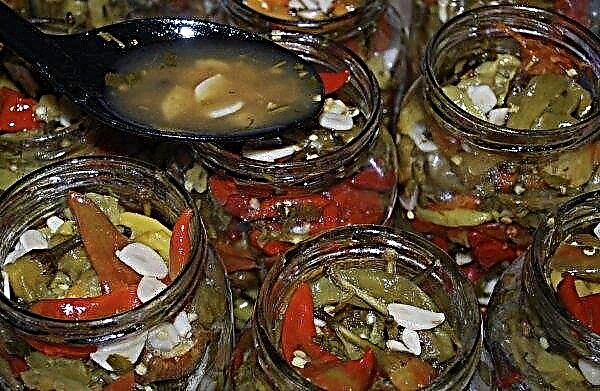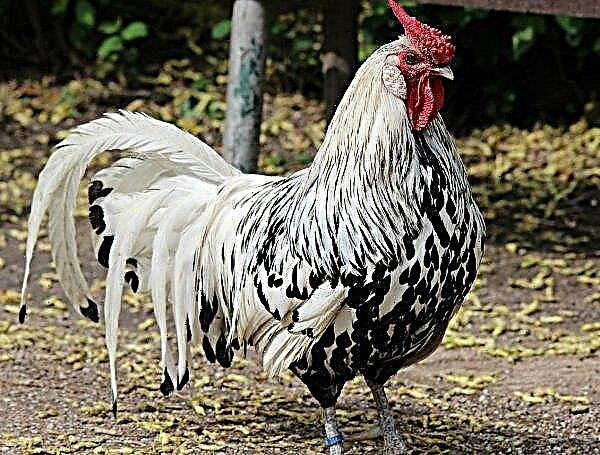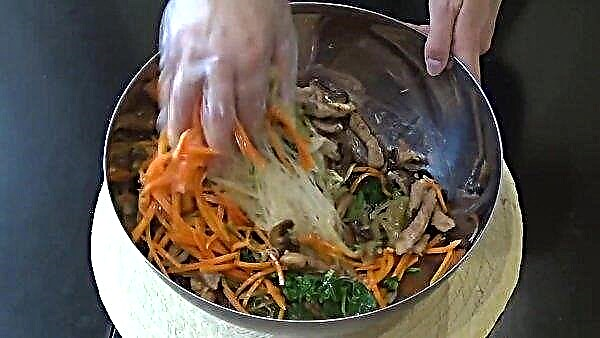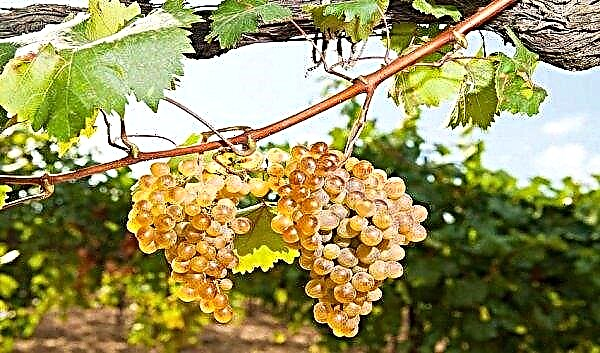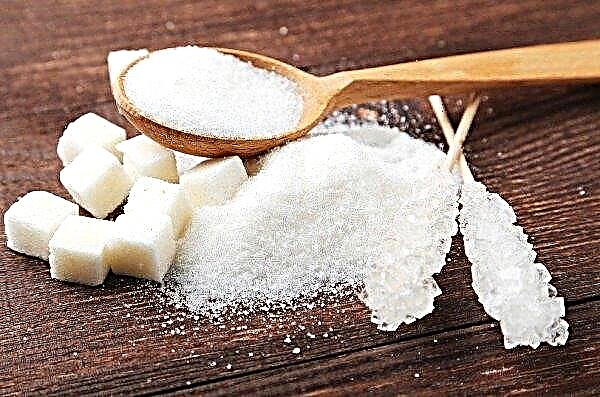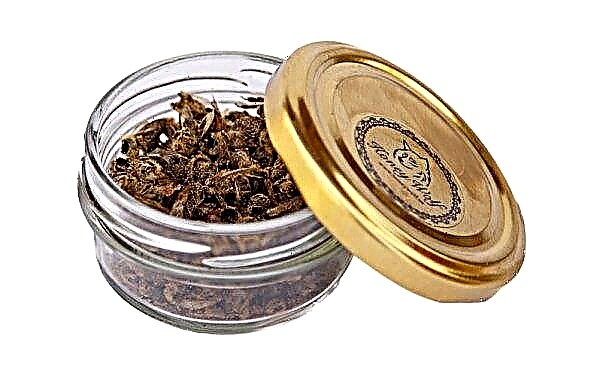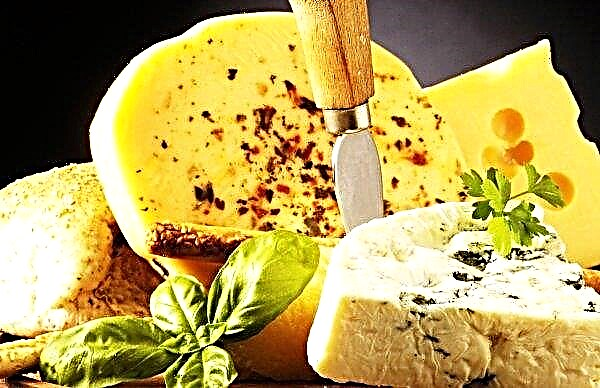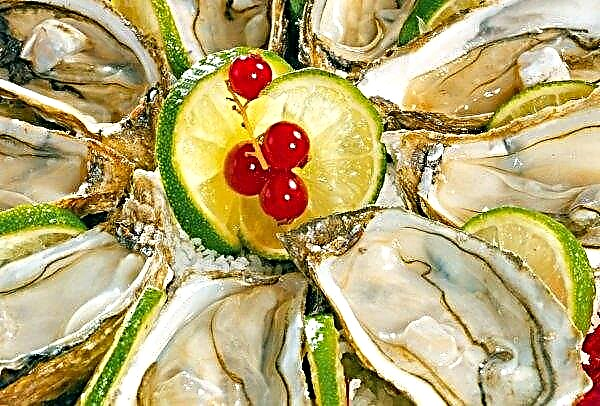Indoor jasmine is an incredibly beautiful plant belonging to the family of Olives. The homeland is a number of states with a tropical or subtropical climate: India, China, Africa and the United States of America. The life expectancy of the bush in natural conditions is approximately 15–20 years, while in indoor plants the period slightly increases.
Varieties of Homemade Jasmine
Contrary to the fact that the genus of Jasmins has more than three hundred species, only a few can be grown in home floriculture, and they all differ in a number of indicators. After reading the information below, you can choose the most suitable.
Did you know? Jasmine tea is a great help in the fight against sore throat, stomatitis, fever and depression.
Multifloral jasmine
A plant belonging to this species can be described as an evergreen shrub or a lowered liana with simple leaves resembling their shape of a lancet, their length reaches 3.5 cm.
Closer to the base of the foliage resembles a heart, and upward is more pointed. Flowering occurs in January - March, the flowers are white and large, exude a pleasant aroma. The species was first bred in the northern region of the island of Borneo.

Large flowered
Such evergreen shrubs and vines have bare stems that can grow up to 8–10 m in length. The color of leaf blades is dark, they are opposite. Flowers are collected at the tops of shoots in the so-called "umbrellas", up to 10 pieces each.
The peak of occurrence is June - October. The limb of the plant consists of 5 perfectly white petals with a characteristic aroma. The flowers themselves are quite large, have an elongated shape of a tube that has blossomed around the edges.

Jasmine Bis or Shrub Liana
Unlike large-flowered, bis jasmine has shoots with a maximum length of 2 m. Under natural conditions, this species is found along the river banks, as well as in Western China, in mountainous areas up to 2500 m above water level. Creepers are covered with axial furrows. Flowering falls at the end of spring, short.
Did you know? Jasmine is considered a flower of love because of the motivation of sensuality and increased sexual desire.
Plates of dark green color, simple, located opposite. Pointed at the apex, found in the form of an egg or lancet. The flowers are characterized by a pronounced pleasant smell, pink or more lilac shades of the petals. Grouped on the tops of the branches in a brush for 2-3 pieces.

Blueflower
This species consists of weakly branching shrubs. Compared to the rest of the varieties, the hollow-flowered jasmine has quite a few foliage on the shoots. In the people it received the name "winter", since its flowering falls in January - April.
The leaves are quite small, bright green. With the onset of frost, they fall or remain in small quantities. The flowers are bright yellow, large (4 cm or more). Blossom in the axillary buds of leaves alternately, over the entire length of the stems.
Jasmine sambac
The variety is considered the most common due to its unpretentiousness in care, even a warm wintering is suitable for it. Asia is considered to be the homeland, or rather, its tropical areas. In nature, shoots can reach 6 m in length, but they are omitted and after a certain time harden, acquiring the properties of wood.
 Exist exclusively in white, bloom from March to October.
Exist exclusively in white, bloom from March to October.
As in all other varieties, the foliage is located diametrically, their shape resembles an egg. Often 2-3 flowers growing close to each other form brushes. The collected inflorescences have a pleasant aroma, are simple, terry and semi-double.
Primrose
Primrose jasmine is a fast-growing bush with thin vines, for which it is necessary to create a support. The flowers are massive, saturated yellow, there is no aroma, which increases the similarity with primrose. They bloom in May - June.

Madagascar Jasmine
Distributed in Japan, China, Madagascar and the islands of the Malay archipelago. The species is considered relatively new and difficult to maintain. The leaves are oval, dark green. Inflorescences are white, cream, pale purple and pastel yellow.
Flowers grow in bunches of 6-7 pieces, flowering falls throughout the summer. Moreover, when following the care rules, the plant is able to pleasantly surprise the owners with its flowering even in winter.

Home indoor jasmine care
Owning indoor jasmine means providing him with suitable growing conditions and providing thorough care. Small discrepancies with the rules and recommendations lead to a lack of flowers, but complete neglect leads to the death of the plant in the shortest possible time.
Temperature and lighting
Both warm and cool rooms are suitable for this plant, but in winter it is recommended to create coolness (+8 ... + 10 ° С) - this contributes to plentiful flowering. If the specified limits are exceeded, the bush will begin vigorous activity much earlier than expected and forms greenery, but not flowers. In spring - in autumn, the optimum temperature should be maintained - +18 ... + 25 ° С.
Important! To avoid sunburn, indoor jasmine is adapted to a new level of illumination in stages.
Airing should be regular, but you should carefully monitor that drafts do not form.Jasmine is a photophilous shrub, but keep in mind that the direct rays of the sun often lead to its death. It is a good idea to put it where the light is bright and diffused - for example, western and eastern windows.
 Location on the south side provides the plant with shade from the direct afternoon sun, while the north side, on the contrary, can cause a lack of light for good growth and plentiful flowering.
Location on the south side provides the plant with shade from the direct afternoon sun, while the north side, on the contrary, can cause a lack of light for good growth and plentiful flowering.
In a period of calm, culture does not need additional lighting, but with the onset of winter it will be needed. In summer, the pot is taken out to an open area (porch, balcony or plot), having organized shelter from a direct stream of light.
Watering frequency and air humidity
Jasmine needs abundant watering with soft, defended warm water as the top soil layer dries from spring to the first month of autumn, and then the amount of moisture is gradually reduced. With the advent of frosts, the procedure should be performed very carefully so that an overflow does not form.
1-2 times a month, experienced plant growers recommend pouring jasmine with an acidified solution, which can be prepared with your own hands, taking 1 liter of water and adding 5-6 ml of apple cider vinegar or 3-4 grains of citric acid.

The plant needs high humidity, you can create it in several ways:
- carry out spraying with settled water at room temperature daily;
- place the container with shrubs on a stand with moistened peat, moss or expanded clay gravel;
- purchase a special humidifier.
Spraying is not carried out during the flowering period, as well as in winter.
Top dressing
Contribute nutrients only during active vegetation and ripening. The optimal solution is to use complex fertilizers created for indoor plants. In the mentioned period, top dressing is carried out 1 time per week. At the end of flowering, feeding is also stopped.
Important! It is advisable to give preference to liquid formulations, since jasmine does not interact very well with substances of prolonged exposure.
Pruning and pinching
To form a magnificent crown of the correct form, you need to resort to pruning, a dormant period is considered a favorable time (February - March). Indoor jasmine tolerates forming pruning well.
At the same time, the lateral shoots are made shorter in order to obtain abundant flowering and restrain growth. Every year, before the start of the growing season, it is recommended to remove the length of all branches by about half. If the shoots are weak, it is better to cut them off completely.

Pinching is carried out every month for young shrubs when 7-8 pairs of young leaves appear on the upper part. The procedure stimulates the branching of shoots. Winter-flowering species are sheared in autumn when a period of activity begins.
If the variety manifests itself in rapid growth, it is allowed to pinch it twice a year: before the flowering begins and at the end of the growing season. However, the previously mentioned sambac, due to its characteristics, is subjected to the procedure more often.
Transfer
After buying and adapting the shrub to a home environment, it is transplanted into a larger pot. The first few years, an annual transplant is mandatory, and after that the number of times is reduced to once every 2-3 years.
Keep in mind that each new pot is selected a few centimeters more. For this process, any light and nutritious soil that can be purchased or prepared independently is suitable.

In the second case, you will need:
- deciduous humus - 1 part;
- turf soil - 1 part;
- greenhouse or humus soil - 1 part;
- peat - 1 part;
- coniferous substrate - 0.5 parts;
- sand - 0.5 parts.
All elements are thoroughly mixed and ready for transplantation directly. Performing the procedure, it is necessary to carefully handle the root system, avoiding crowding, they need to be straightened with all care. Good drainage is the key to the healthy development of jasmine. If you neglect it, the root system can rot.
Did you know? The smell of the plant becomes most saturated closer to the night. This occurs due to a change in ambient temperature, which stimulates the opening of flowers.
Jasmine-like flowers
The most similarity to the described culture is the mock-up, not for nothing that its second name is "garden jasmine." This plant is easier to care for and more likely to take root in the garden, as the climate zone of Russia impresses him.
 And the difference between it and real jasmine is very small - the first has a less sweet and rich aroma, but in appearance they are almost identical.
And the difference between it and real jasmine is very small - the first has a less sweet and rich aroma, but in appearance they are almost identical.
Another extremely similar to jasmine sambac is carissa - this shrub belongs to the genus Kutra. Small-flowered inflorescences located at the ends of the stems or in the sinuses are white or pink. The main difference is that carissa has a less strong aroma, but quite similar.

Homemade jasmine, though capricious, but if you make an effort and provide it with suitable conditions, the bush will meet all expectations with incredibly beautiful flowers with a bewitching aroma.

